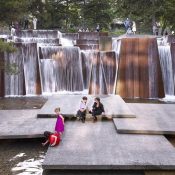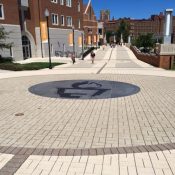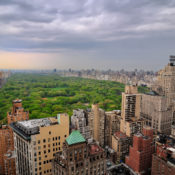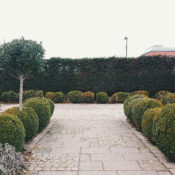Author: Land8: Landscape Architects Network
New International Landscape Architecture Prize Announced by TCLF
Aiming to raise the visibility of the field and its practitioners, The Cultural Landscape Foundation (TCLF) has established an international landscape architecture prize of $100,000 to be awarded every two years, beginning in 2021. In addition, the Prize features two years of related public engagement activities to honor a living practitioner, collaborative or team for their creative, courageous, and visionary work in the field of landscape architecture.
TCLF board co-chair Joan Shafran and her husband Rob Haimes have generously provided a lead gift of $1 million to underwrite the Prize, which was collectively matched by the rest of the board and other donors, launching a $4.5 million fundraising campaign to endow it in perpetuity.
“Landscape architecture is one of the most complex and, arguably, the least understood art forms. It challenges practitioners to be design innovators often while spanning the arts and sciences in addressing many of the most pressing social, environmental, and cultural issues in contemporary society.” – Charles A. Birnbaum, FASLA, FAAR, TCLF’s founder, president, and CEO.
Landscape architects, artists, architects, planners, urban designers, and others who have designed a significant body of landscape-architectural projects are eligible for this award. The Prize will examine the state of landscape architecture through the honoree’s practice, showcasing how landscape architecture and its practitioners are transforming the public realm by addressing social, ecological, cultural, environmental, and other challenges in their work.
“Our involvement with TCLF, and seeing and learning about the inspired work of landscape architects, led us to think about how to raise the public’s awareness of their contributions in a more dramatic way. Supporting the Prize came out of that,” said Joan Shafran and Rob Haimes, lead donors for the prize. “We hope the Prize will provide not just recognition of exceptional people and projects but also promote a wider public discussion of the role of landscape architecture in life.”
The honoree will be chosen in a multi-layered process, including a year-long nomination period followed with selection by a five-person jury comprised of internationally prominent landscape architects, artists, educators, designers, and others. The Prize will be administered by TCLF and overseen by an independent curator.
About The Cultural Landscape Foundation
The Cultural Landscape Foundation is a Washington, D.C.-based education and advocacy non-profit established in 1998 with a mission of “connecting people to places.” The organization educates and engages the public to make our landscape heritage more visible, identify its value, and empower its stewards. The international prize will become TCLF’s fourth major program along with: What’s Out There, an exhaustive, carefully vetted and profusely illustrated database of more than 2,000 landscapes; Pioneers of American Landscape Design, featuring online and print biographies of more than 1,000 landscape architects and allied professionals, along with video oral histories; and Landslide, the advocacy initiative that draws attention to threatened and at-risk landscapes and includes an annual thematic report and traveling photographic exhibitions. TCLF also organizes conferences, tours and other events, and its work has received numerous awards, as well as repeated support from the National Endowment for the Arts.
—
Lead Image: Portland Open Space Sequence, Ira Keller Forecourt Fountain, Portland, OR, 2016. Designed by Lawrence Halprin with Angela Danadjieva, 1970. Photo © Jeremy Bittermann, courtesy The Cultural Landscape Foundation.
Vectorworks Design Scholarship – Apply to Win $10,000!
Attention all landscape architecture students, undergraduate, graduate, or recent graduates! Submit your best work to the 2019 Vectorworks Design Scholarship for a chance to win up to $10,000 USD, gain professional recognition, and propel yourself into a bright future of design.
The application period runs now until August 29, 2019, at which point designs are due for two rounds of judging. A panel of judges will evaluate submissions based on design integrity, originality, effective use of computer technology, and communication of design vision.
First-round winners will receive $3,000 USD and will be entered for a chance at the grand prize Richard Diehl Award, worth an additional $7,000 USD. Winners will then be revealed on October 16, 2019.
“The Vectorworks Design Scholarship is an incredible opportunity for up-and-coming designers to promote their work and win funds to support their future endeavors,” said Alice Lowy, marketing programs director at Vectorworks. “We look forward to seeing what these up-and-coming designers think of next.”
As if you needed another reason to submit, Vectorworks is offering an award outside of the cash incentive: winners’ schools will also receive free Vectorworks Designer software and complimentary training for faculty and students.
“Submit anyway, even if you think your work isn’t going to win. Be sure to write about the heart behind your project,” said Morgan Lindsay Price, a previous winner of the Vectorworks Design Scholarship, when asked what advice she’d give to prospective applicants. “I was so shocked and grateful that we won. Vectorworks gave me a huge opportunity that I never dreamed I would have had, and I’m eternally grateful.”
The submission only requires you answering a few questions in 150 words or less about your best individual or group project, then attaching your work.
For more information on the competition structure, eligibility, and application materials, visit: vectorworks.net/scholarship.
Don’t delay – apply today here!
Land8 “Happy Hour” Comes Full Circle in Philly
If you’ve ever attended the ASLA Meeting + EXPO over the last decade, there’s a good chance you attended or at least heard about the famous Land8 Happy Hour that bills itself as “The Largest Party for Landscape Architects in the World.” It’s only natural that the largest gathering of landscape architects (ASLA Meeting + EXPO) also includes the largest social event too with over 700 attendees expected at the Happy Hour.
The 11th Annual Land8 Happy Hour returns to the city of its very first Happy Hour on October 21 at 8pm and includes an open bar, limited edition t-shirt, photo booth, networking, raffles, pub games, and dancing! Register here.

The first Land8 Happy Hour in Philly 2008 | Photo: Kevin Gaughan
So why is it called a “Happy Hour” if it’s a late night event? Land8 Managing Partner, Matt Alcide, states that it’s a nod to Land8’s humble beginnings. At the inaugural Land8 Happy Hour in Philadelphia in 2008, it truly was a traditional happy hour with about a dozen attendees and a few pitchers of beer. While the size of the gathering has changed, the purpose has not, which is to bring landscape architects together in a relaxed informal setting to kick back after long days of meetings and educational sessions.
If you’re in town Sunday evening 10/21 in Philly, be sure to get your tickets ahead of time at land8.com! The Land8 Happy Hour is made possible by the event sponsors Anova Furnishings, Vectorworks, and Permaloc.
REGISTER HERE >
—
This article originally appeared in ASLA’s LAND.
Paveshare.org Now on Land8!
PaveShare.org open-education curriculum for landscape architecture students and educators is now available through the Land8: Landscape Architects Network.
PaveShare.org, a free ICPI resource, links to self-guided presentations with interactive animations and a studio project library on segmental concrete pavement design and construction. Educators can supplement existing curriculum with resources from PaveShare.org and encourage students to add to a living library by uploading their completed projects to the site. Students and educators can also explore pattern design and structural principles or utilize a curriculum path.
“Segmental concrete pavement systems provide landscape architects with a proven, flexible, and durable method that also allows tremendous design freedom,” said Kendall Anderegg, ICPI Board Chair. “By teaming with the Land8 network, ICPI brings innovative design ideas and technical information to landscape architecture students and educators in a free, easy-to-use manner.”
PaveShare.org resources include:
- Information about concrete paver composition and uses
- Project design ideas and case studies
- Construction and installation best practices and detail drawings
- Glossary of key terms
- List of resources available from other organizations
“Concrete paver sales in the U.S. and Canada have reached post-recession highs during the last several years,” said Anderegg. “Homeowners and landscape architects frequently choose segmental concrete pavement for residential and commercial projects because of its visual appeal and durability. PaveShare.org helps the next generation of landscape architects address this growing demand.”
Students and educators can participate in the PaveShare.org curriculum by visiting www.land8.com/paveshare and clicking on the “Resources” link above the masthead.
View a video demonstrating how to use PaveShare.org:
LEAD IMAGE: The University of Tennessee at Knoxville incorporated permeable interlocking concrete pavement into a campus center upgrade. PaveShare.org is flexible, living landscape architecture curriculum delivers latest concrete paver design and technical information. View Case Study.
Jane Irwin Landscape Architecture Brings New Life to Constitution Avenue
Article by Maria Giovanna Drago Constitution Avenue by Jane Irwin Landscape Architecture along with Hill Thalis Architecture + Urban Projects, and MEC in Canberra, Australia. Constitution Avenue is a key street in Canberra, Australia. In fact, along with Commonwealth and Kings Avenues, it forms the city’s basic geometric design guidelines that developed Canberra in the 1900s. Situated in a lively area, it’s adjacent to residential and commercial buildings, but also recreational and cultural activities. In 2016, Jane Irwin Landscape Architecture completed the renewal project after four years of construction. The renovation brought modernity to this roadside axis, rewriting its role in the city. We can say that Constitution Avenue was influenced by great western avenues like the Champs-Élysées in Paris or La Rambla in Barcelona. The City Design Walter B. Griffin was an American architect and landscape architect who won the international competition for the design of the new capital city in 1912. He and his wife, Marion, developed a plan and ran an architecture firm together. “I have planned it not in a way that I expected any government authorities in the world would accept. I have planned an ideal city – a city that meets my ideal of the city of the future,” said Griffin.
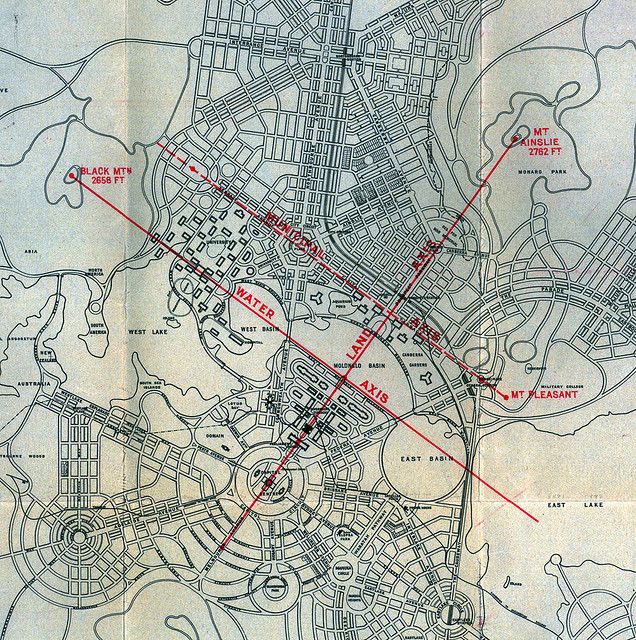
Canberra Design Plan by Walter B. Griffin and Marion M. Griffin took inspiration from Ebenezer Howard’s Garden city movement. Credit: National Archives of Australia
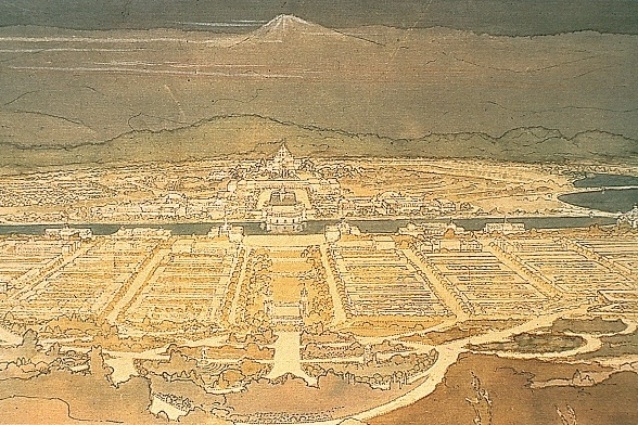
Rendering from the Summit of Mount Ainslie in Canberra by Marion Griffin, 1911. Credit: National Archives of Australia
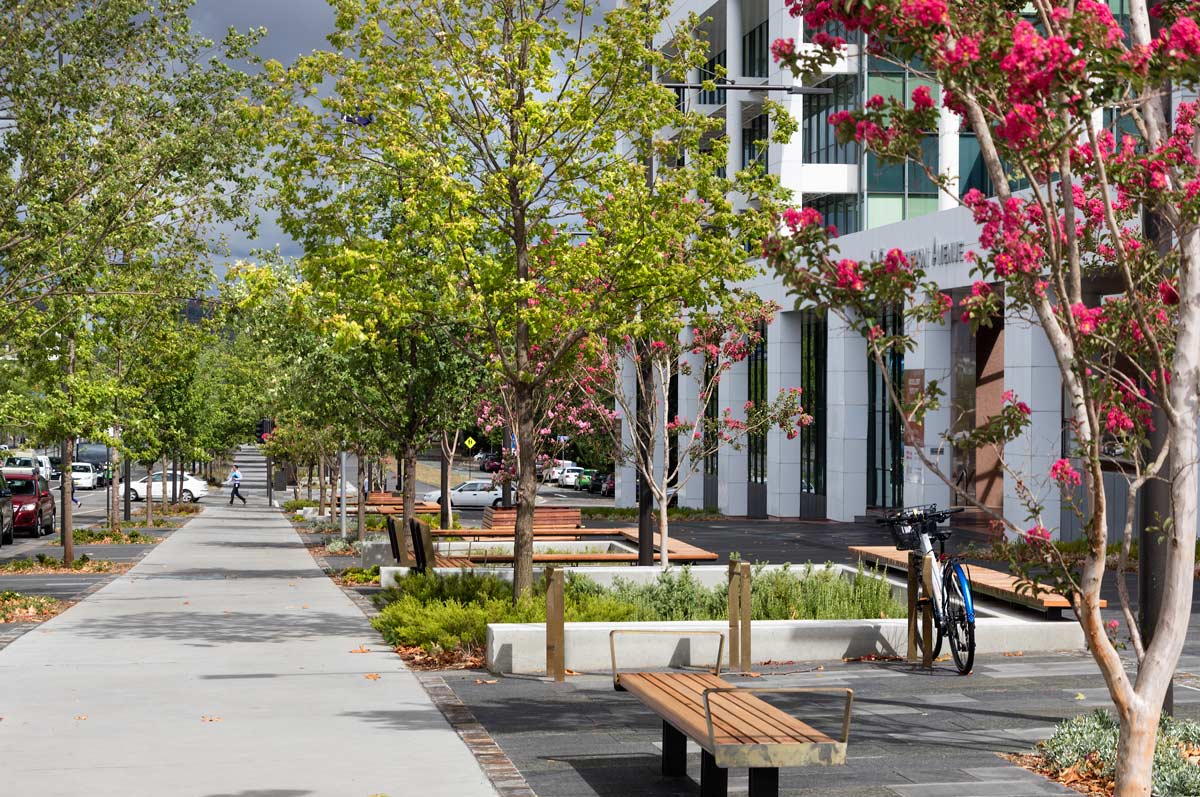
Constitution Avenue designed by Jane Irwin Landscape Architecture. Credit: John Gollings
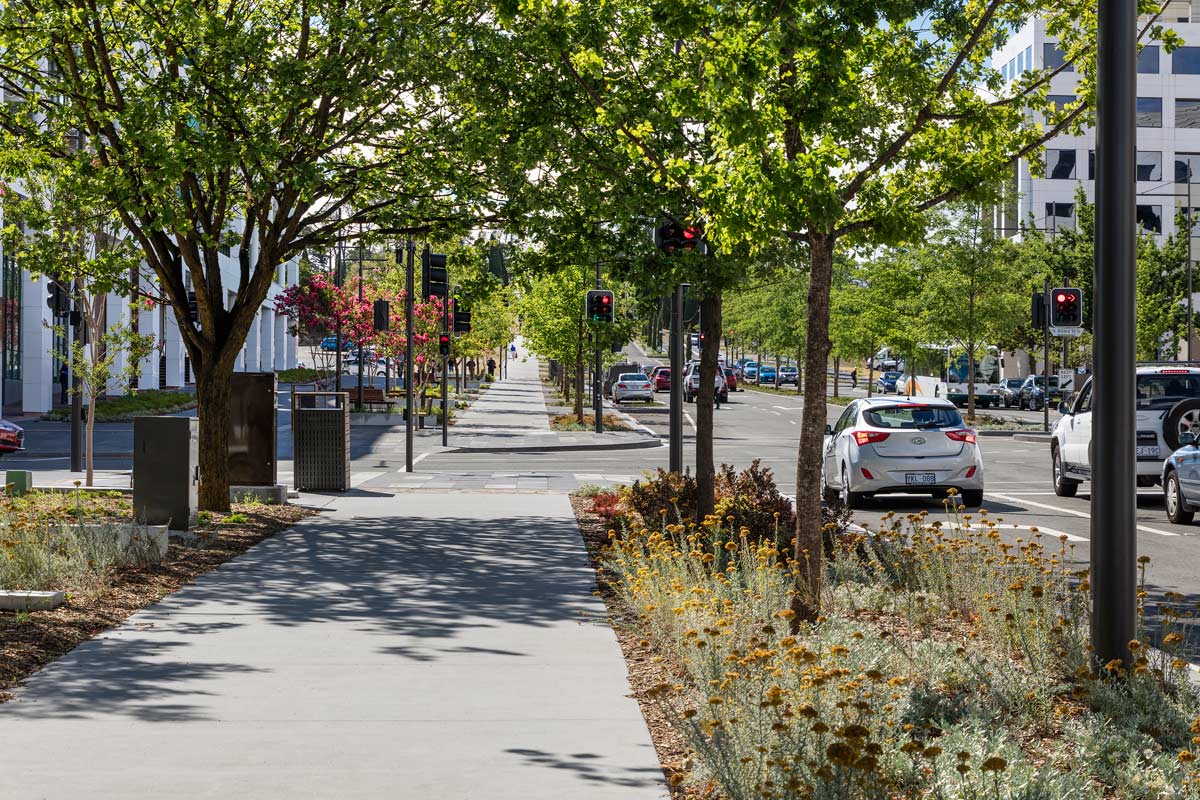
Constitution Avenue facing northwest. Credit: John Gollings
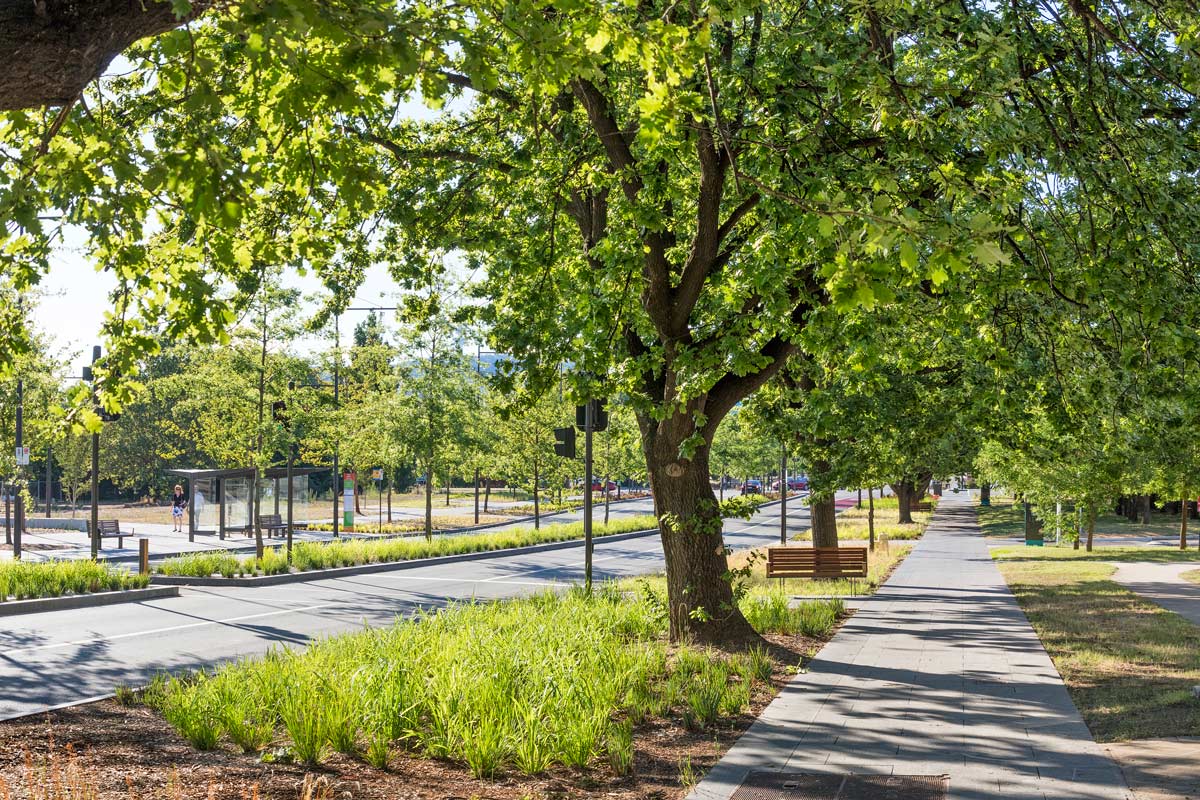
The redesign of Constitution Avenue won the Canberra Medallion as well as the ACT’s top award for urban design. Credit: John Gollings
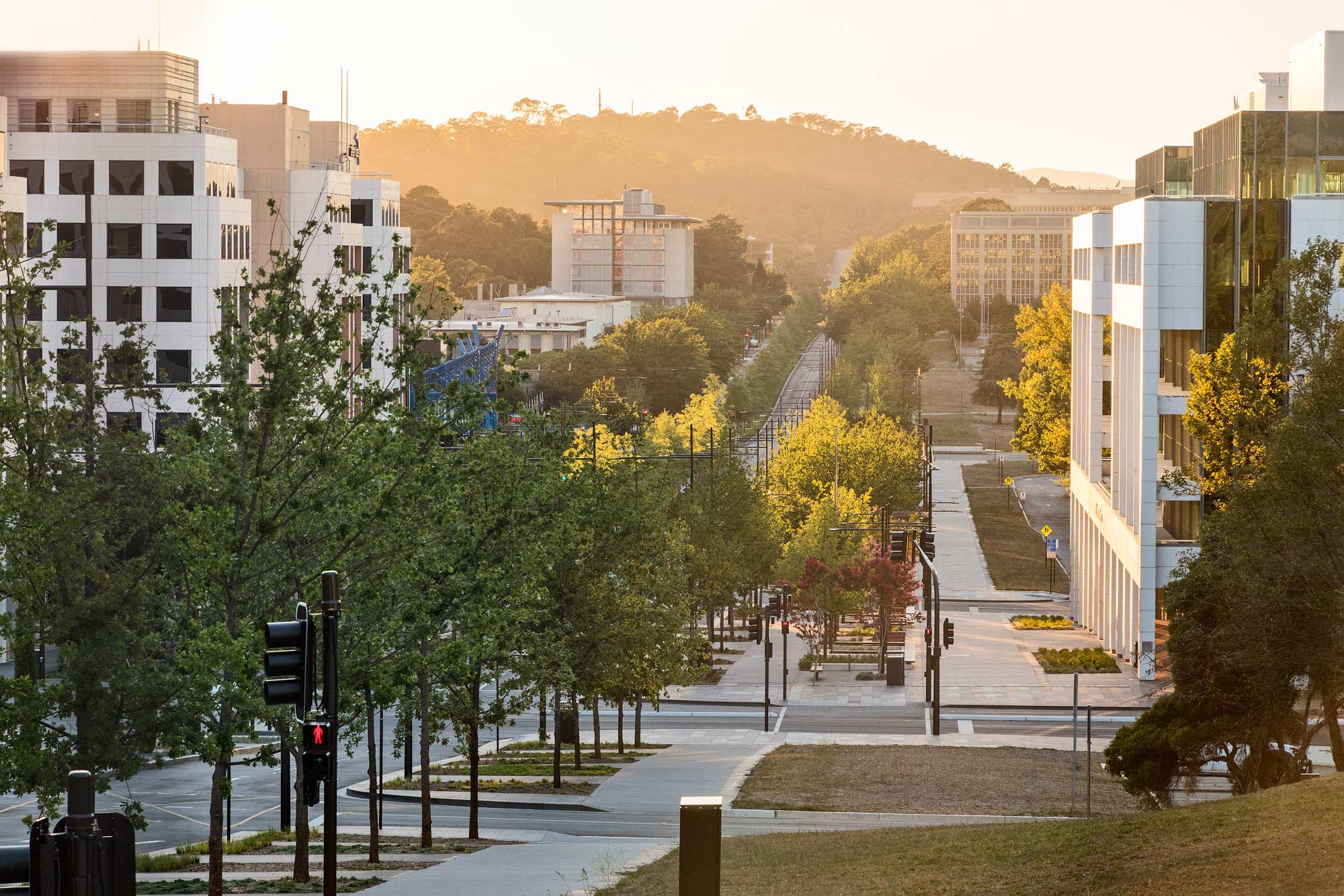
Constitution Avenue. Credit: John Gollings
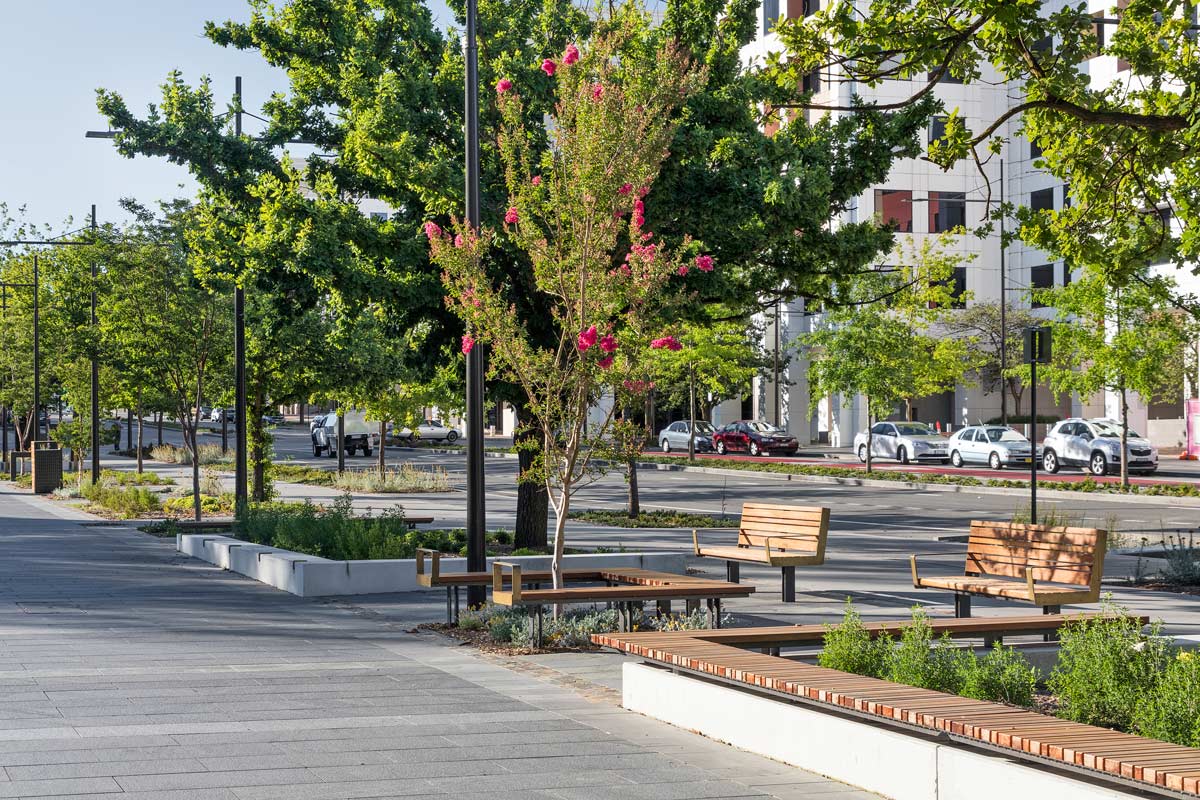
Furniture on Constitution Avenue. Credit: John Gollings
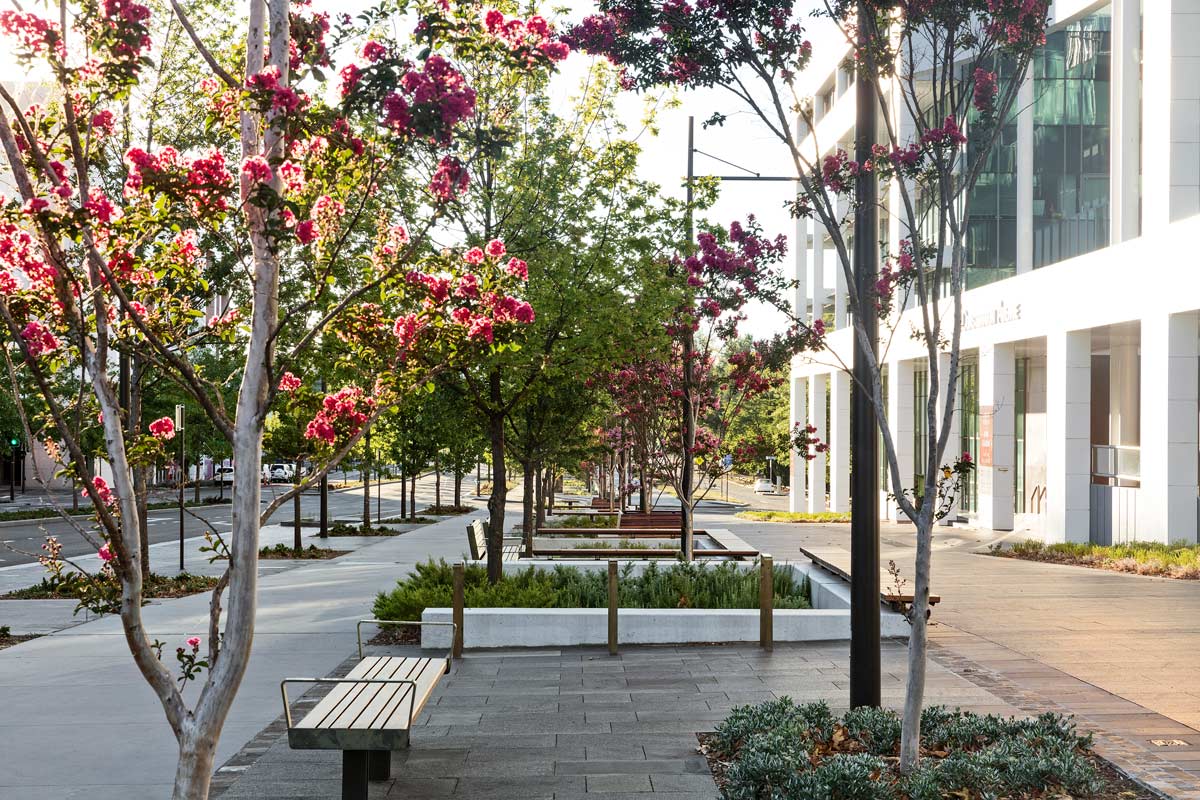
Crepe myrtles in bloom along Constitution Avenue. Credit: John Gollings
- 10 Great Projects Showing why Australia are Leaders in Landscape Architecture by Paul McAtomney
- Streetscape | 5 of the Best Projects Today for Design Inspiration by Kurt Longland
- Buffalo Niagara Medical Campus Turns Sidewalk into Awesome Park by Aybige Tek
Featured image: Constitution Avenue | Canberra, Australia | John Gollings | 2016
5 of the Smartest Drainage Systems
Article by Maria Giovanna Drago We have selected five of the most interesting drainage solutions to show you how their impact could be implemented in the landscape. Are you planning on designing a park or renovating your home garden? While you may already have knowledge of vegetation, outdoor furniture, paving, and lighting—a troubling issue that many are faced with is an excess of water. If it rains too much a garden or park could quickly become a swamp. Once the soil becomes saturated insects start to proliferate in the water, some of which are bearers of diseases. Additionally, overflow water can make moving through a space difficult as well as damage buildings or other structures. Avoid a Bad Design Do not rely on mediocre designed systems. A poor design decreases property value up to 15 percent, without mentioning the aesthetics and usability. It’s always wise to consult an expert and shy away from do-it-yourself methods.
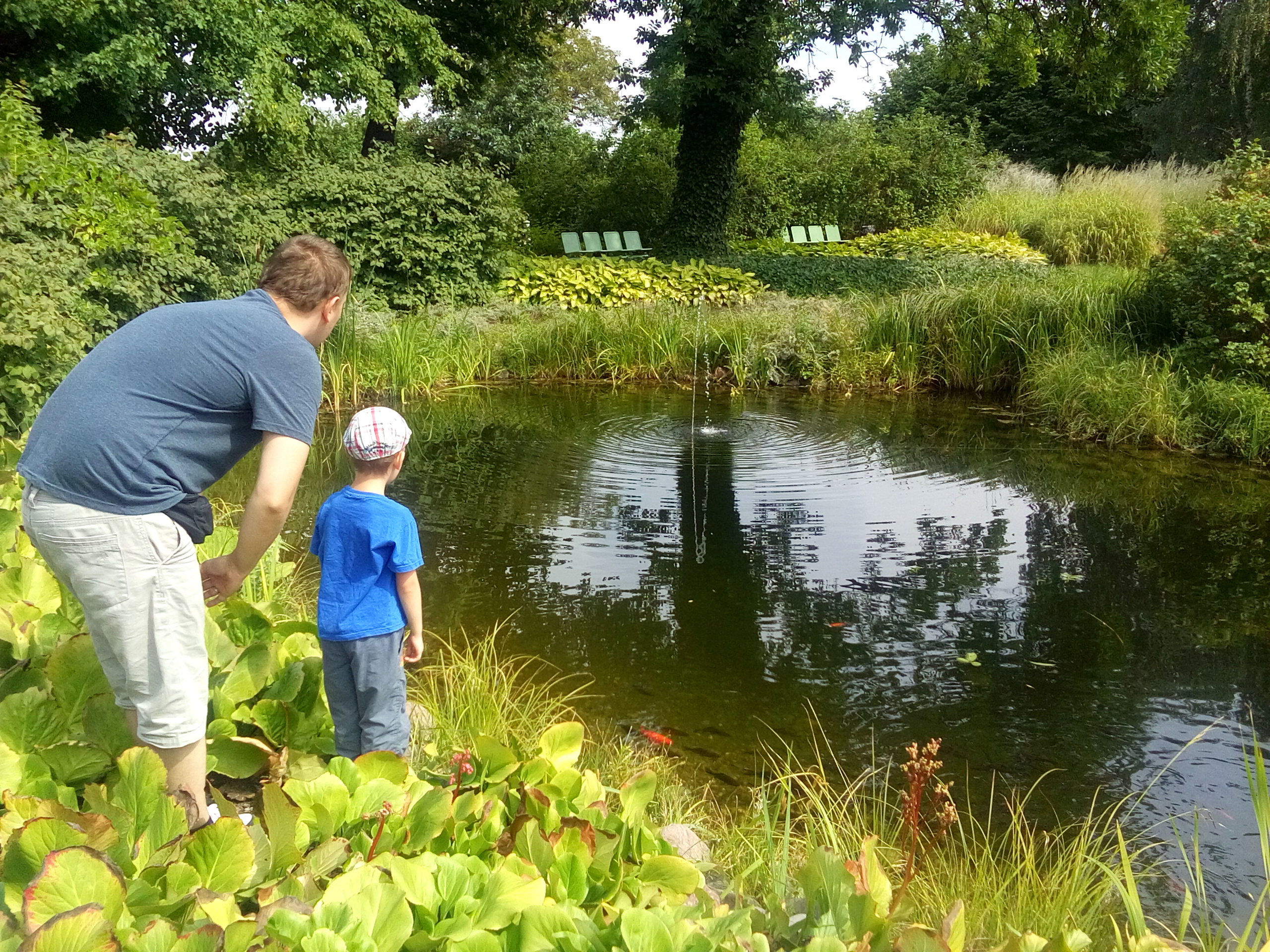
Warsaw University Library Garden located in Poland. Credit: Maria Giovanna Drago

Warsaw University Library. Credit: Maria Giovanna Drago
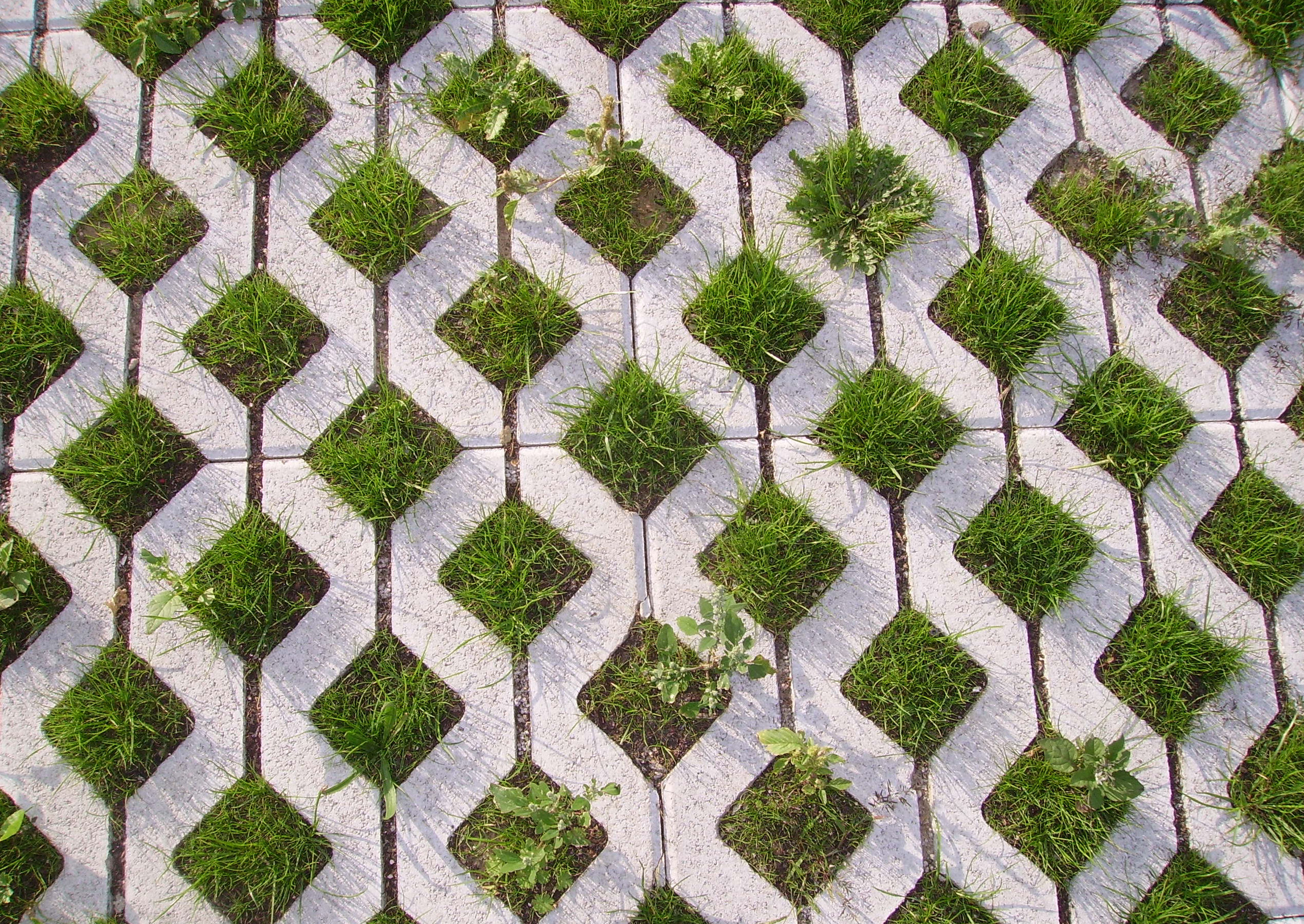
Grass pavement. Credit: Immanuel Giel via CC BY 2.0
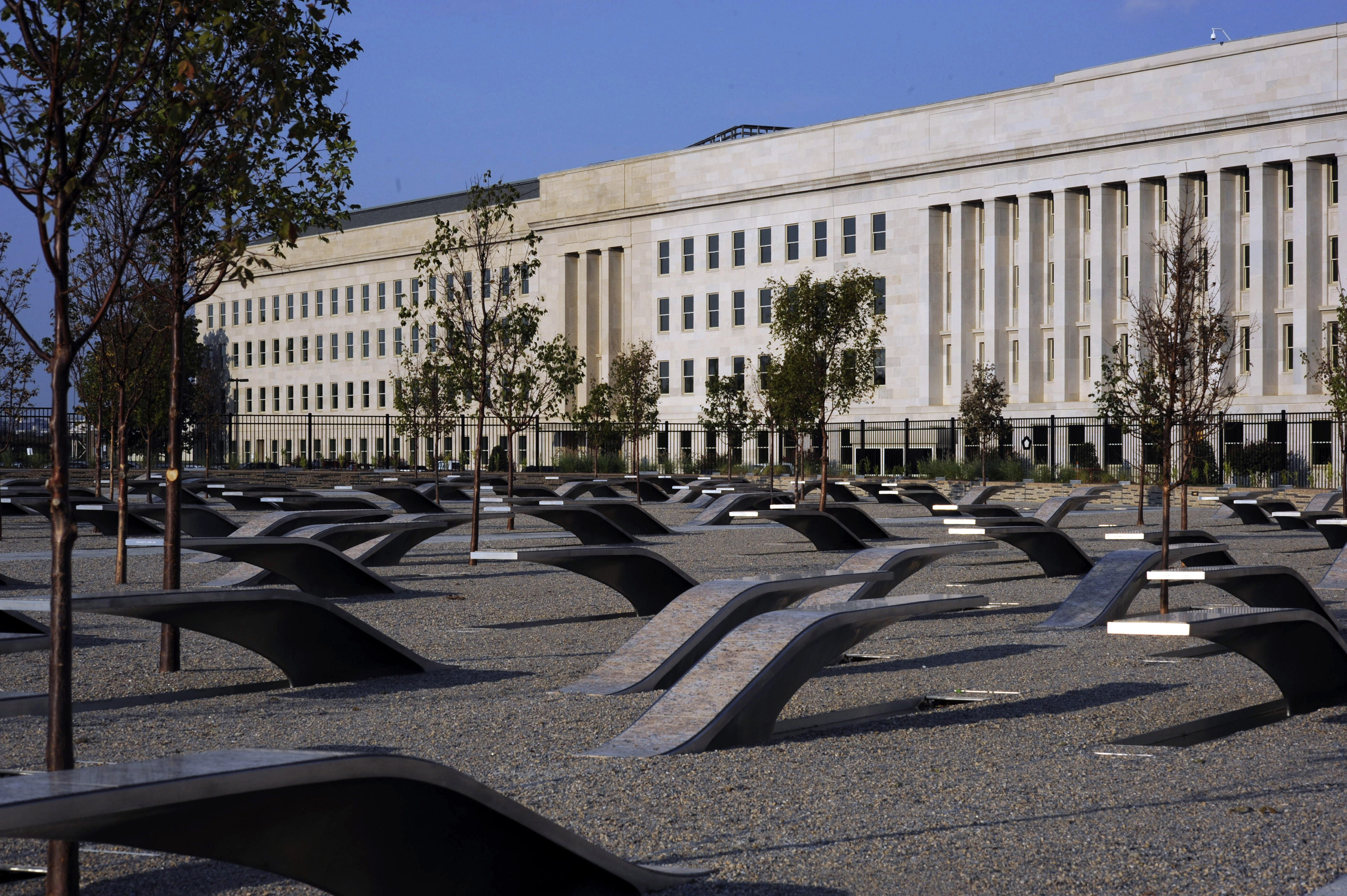
Pentagon Memorial in Arlington, Virginia by Kaseman Beckman Advanced Strategies and Buro Happold. Credit: Brien Aho via CC BY 2.0
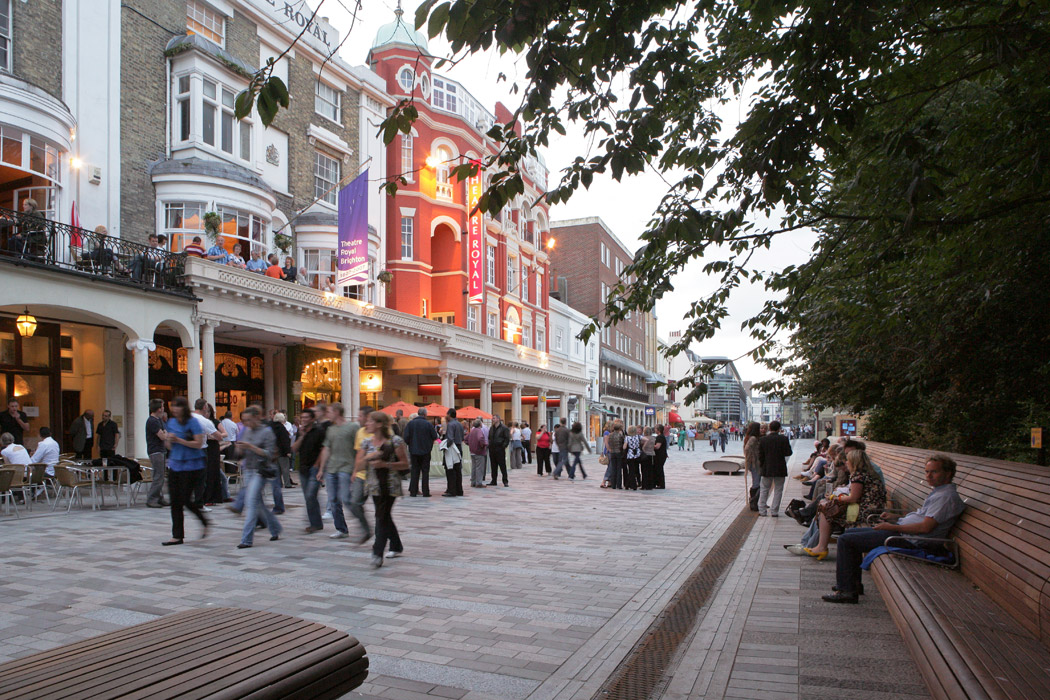
New Road located in the city of Brighton & Hove, UK designed by Landscape Projects and Gehl Architects. Credit: Gehl Architects
- 5 Best Plants for Phytoremediation by Elisa García
- Permeable Pavement: Why We Need Permeable Pavement More than Ever by Frank Bourque
- Quzhou Luming Park Proves that Natural Processes Offer the Most Sustainable Solutions by Erin Tharp
Featured image: Quzhou Luming Park | Quzhou, Zhejiang, China | Turenscape | 2016
What Lessons Can We Draw from One Spadina Crescent?
Article by Moreira Filho One Spadina Crescent by NADAAA with the leadership of Nader Tehrani and Katie Faulkner along with Adamson Associates, Public Work, and ERA Architects in Toronto, Ontario, Canada. Located on Spadina Avenue and the north side of College Street in Toronto, this building was constructed in a roundabout that interrupts and divides the avenue. It’s impossible to pass through without seeing it, as it’s a monumental sculpture that seems to grow into the skies as you approach. Built in 1875 to house Knox College – incorporated by the University of Toronto (U of T) 12 years later – it used to harbor a theological seminary, military hospital, various departments of U of T, and a penicillin factory. Rendering this building, and giving it back to Torontonians and worldwide citizens, while linking the past to a present utilization was a big challenge for the design team. The firm chosen to develop this design was NADAAA, through the leadership of Nader Tehrani and Katie Faulkner in partnership with architect of record Adamson Associates, landscape architects Public Work, and heritage architects ERA Architects. Let’s look at some lessons we can take from them.
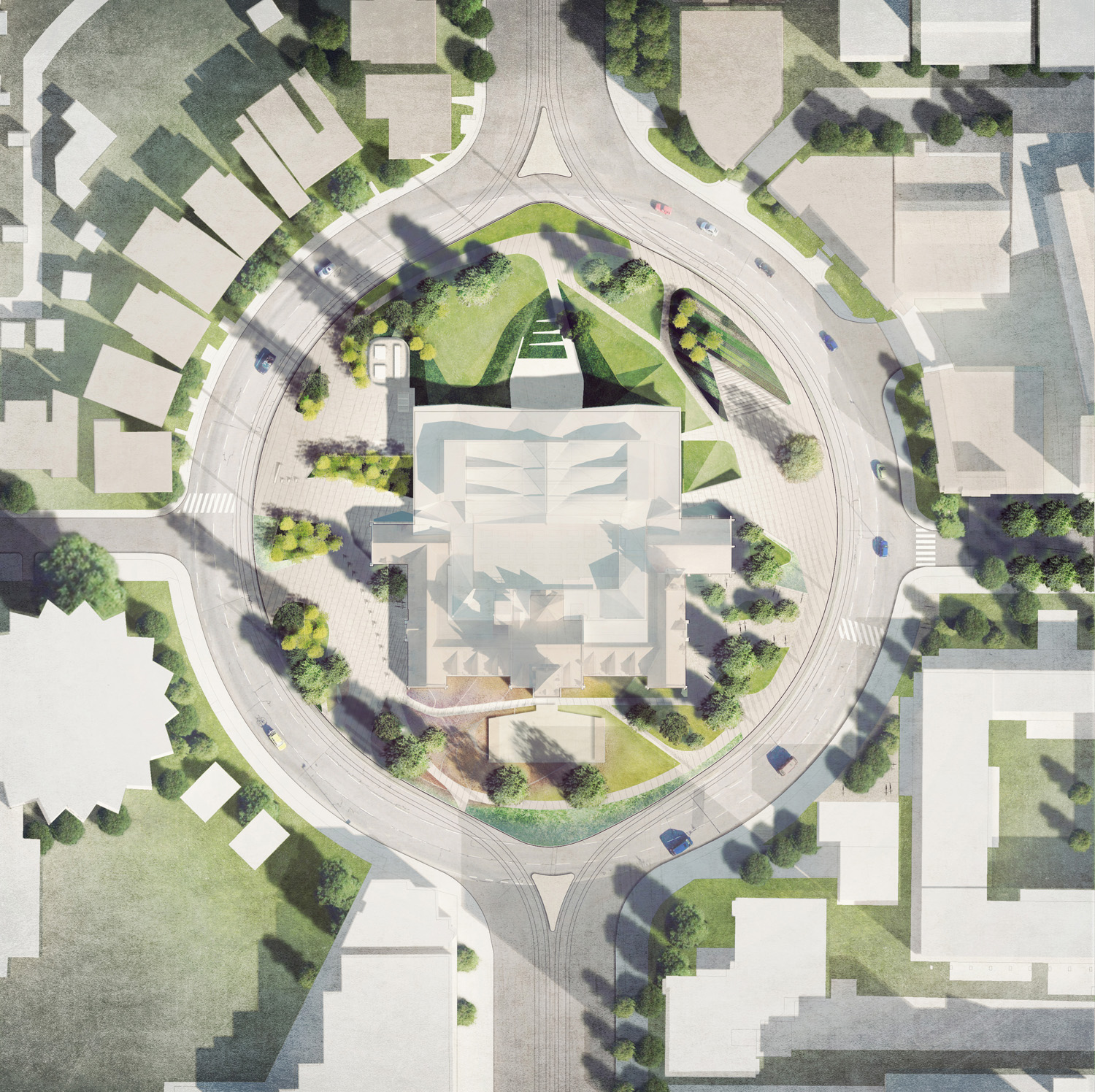
One Spadina Crescent Site Plan. Credit: Public Work
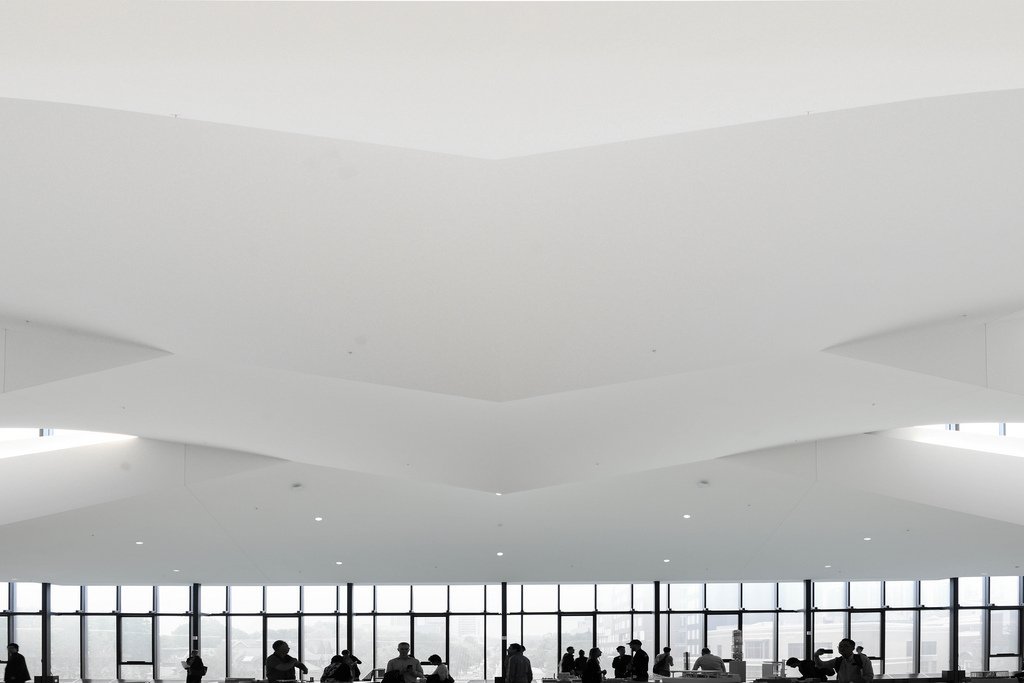
Third Floor Graduate Design Studio. Credit: Lori Whelan

View to the South. Credit: Public Work
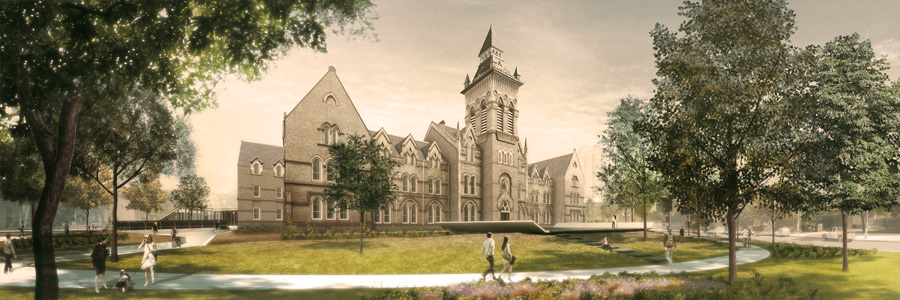
View to the North. Credit: Public Work

View to the East. Credit: Public Work
- Canada’s Got Talent – 10 Awesome Examples of Landscape Architecture in Canada by Paul McAtomney
- Beautiful Plaza Celebrates Canadian Landscape by Alexandra Wilmet
- Sätra Centre: How a Public Square Turned into a Cozy Living Room by Velislava Valcheva
Featured image: One Spadina Crescent, seen from above | Toronto, Canada | Roof Topper | 2017
Two Famous American Urban Parks Demonstrate How Citizens Changed in 160 Years
Article by Maria Giovanna Drago We examine how urban parks in the United States have evolved over the last 160 years through a comparison of New York City’s Central Park and Chicago’s Millennium Park. Society has continually changed throughout history, often in reaction to events and novelties. Important time periods, such as industrial revolutions and wars have influenced the way of life and because of these events some people favored living in fast-paced cities while others in the countryside. These progressions can be seen in the layout of cities, particularly the urban parks. Parks allow us to better understand the struggle between nature and the built environment. Even though it seems that more attention is usually given to the expansion of cities, over the centuries urban green infrastructure has not remained static.
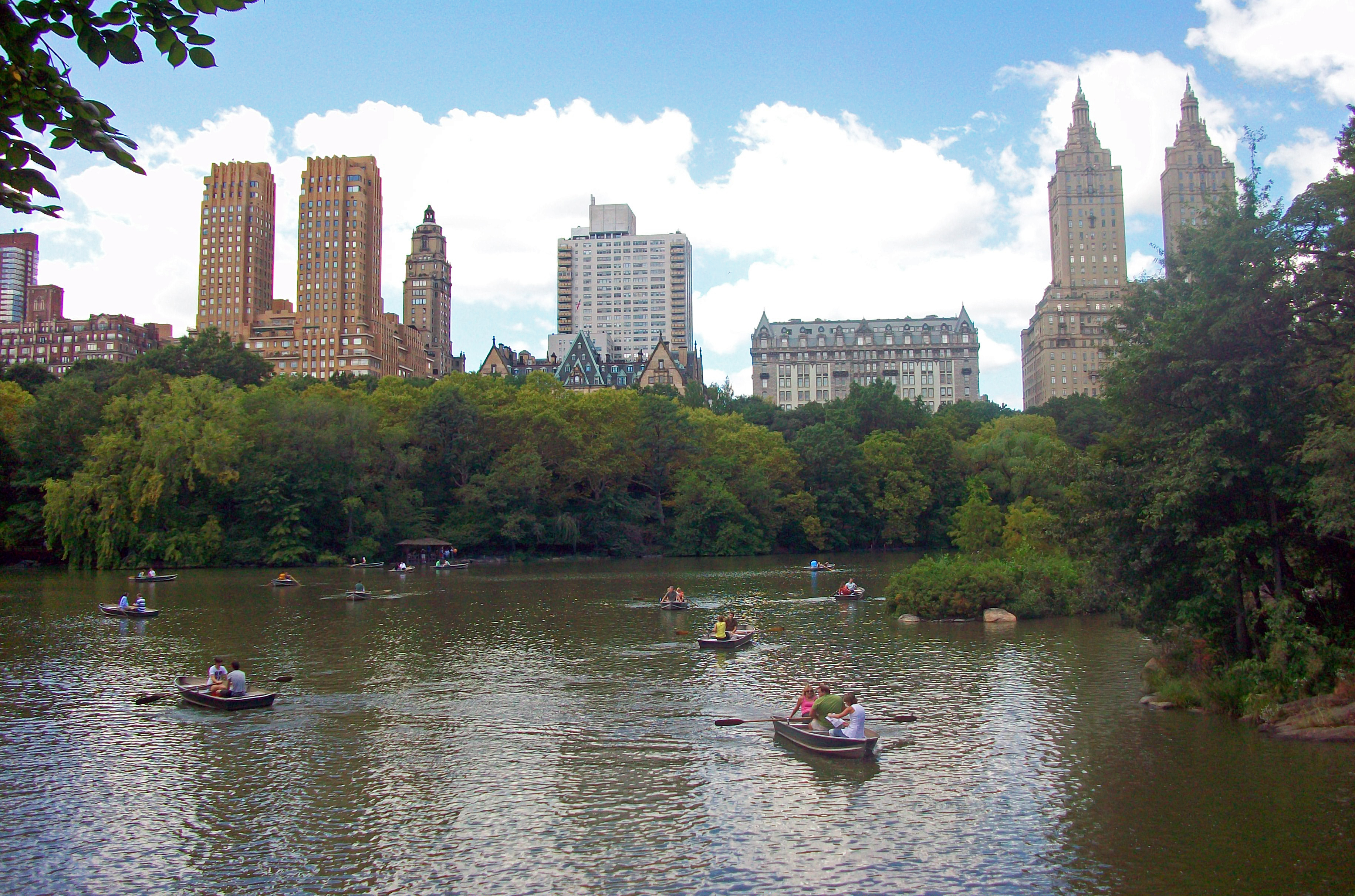
Central Park West Historic District, seen from Bow Bridge over the Lake in Central Park. Credit: CC BY-SA 3.0
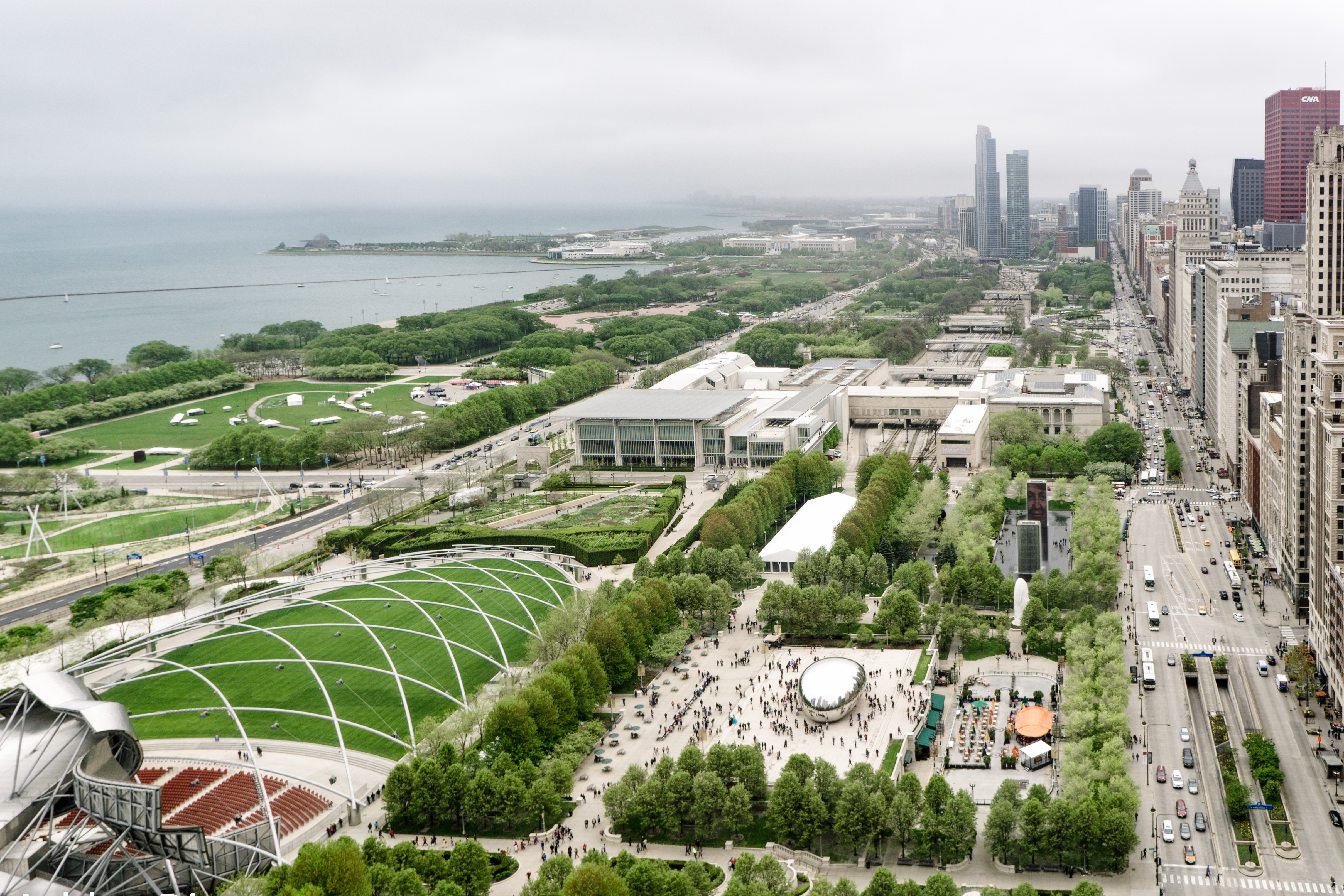
Aerial view of Millennium Park. Credit: Ashley Diener
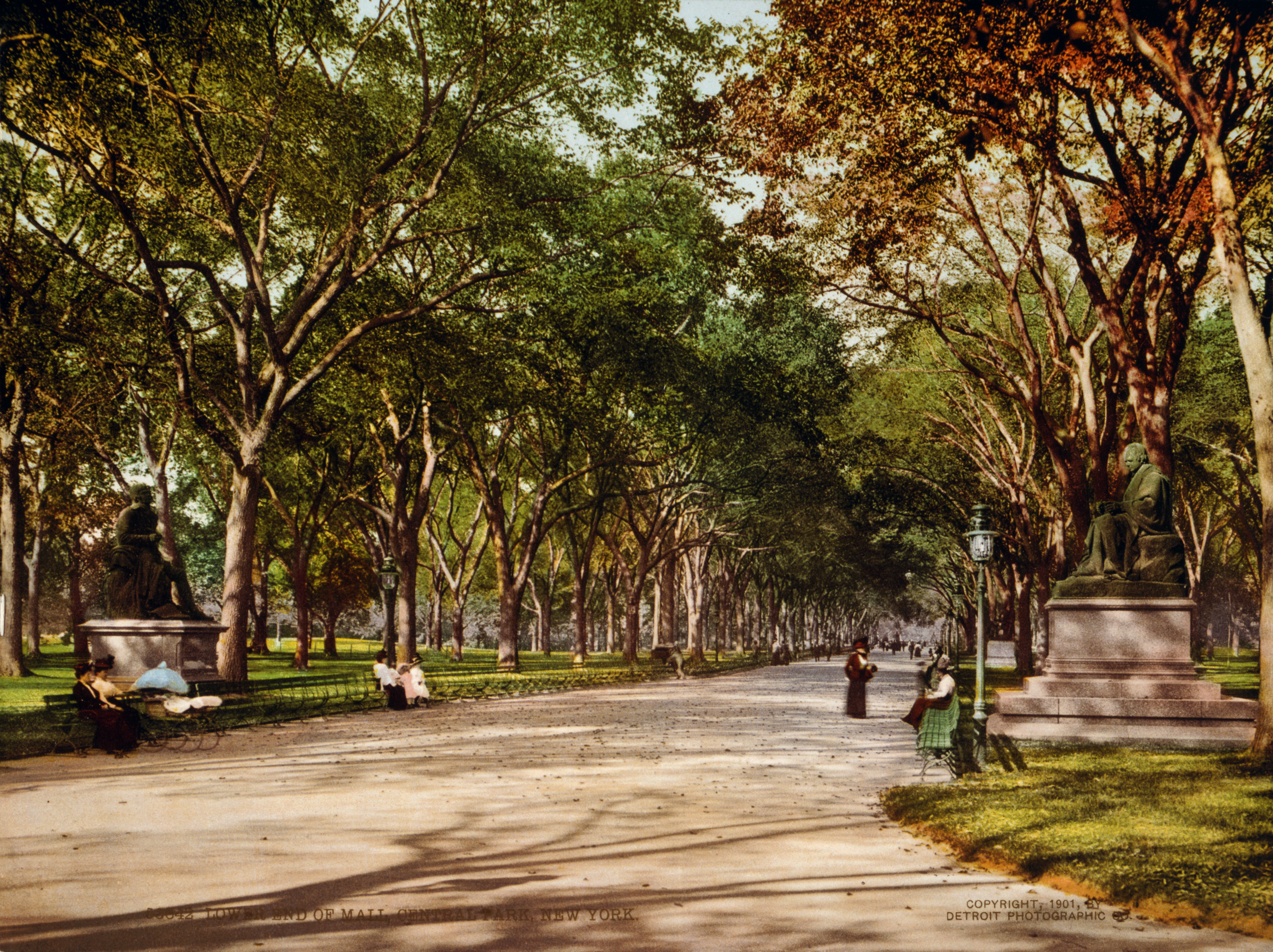
Lower end of mall at Central Park in 1901. Credit: CC BY 2.0
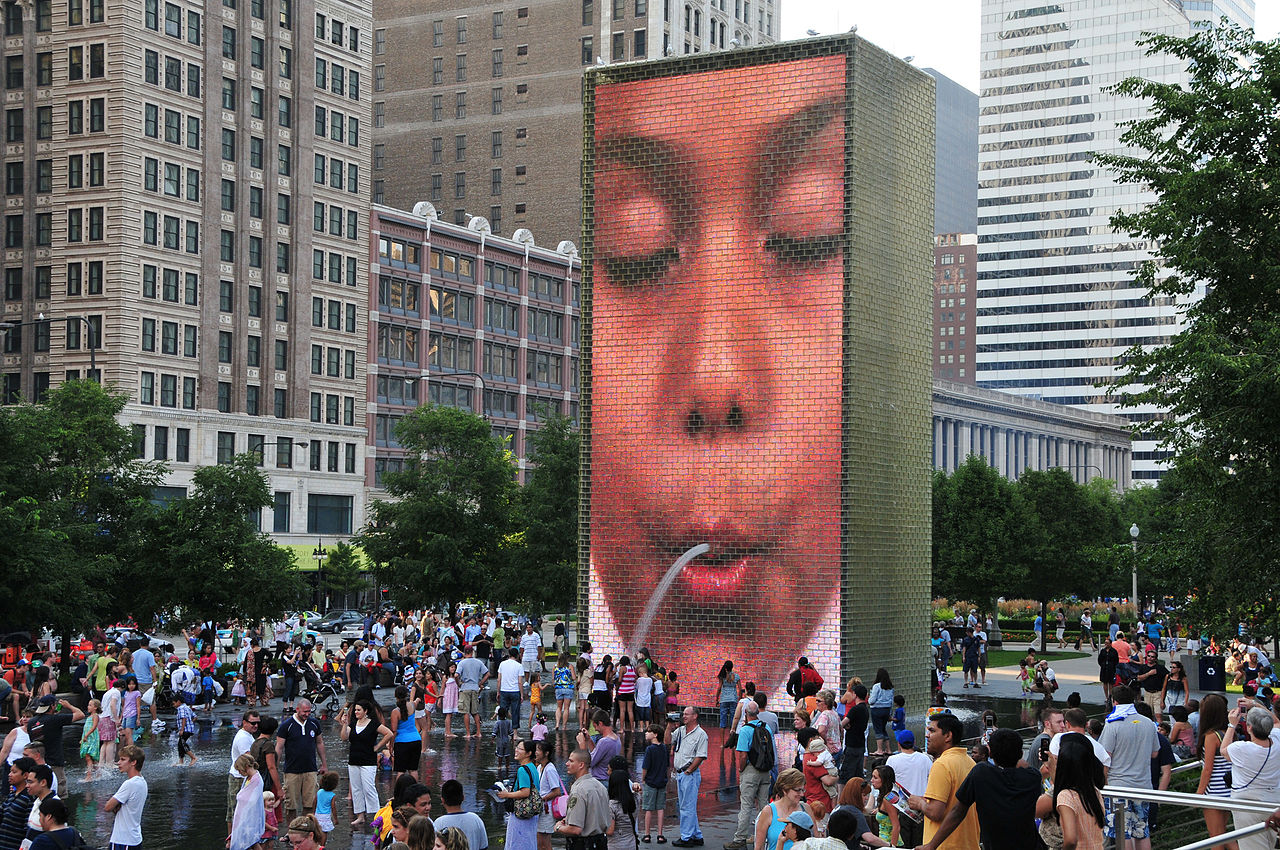
Crown Fountain. Credit: Serge Melki via CC
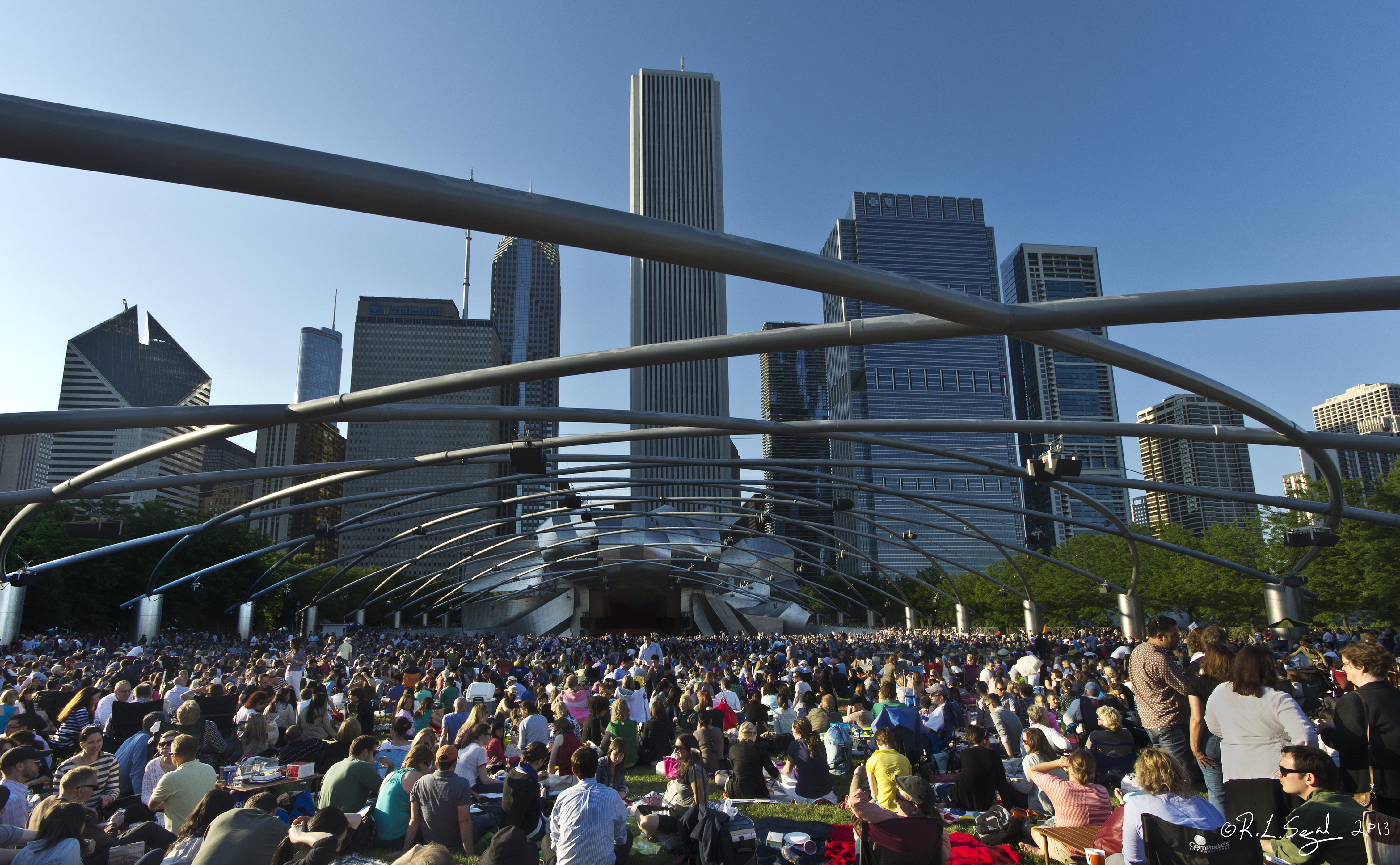
Pritzker Pavilion Great Lawn. Credit: Bob Segal
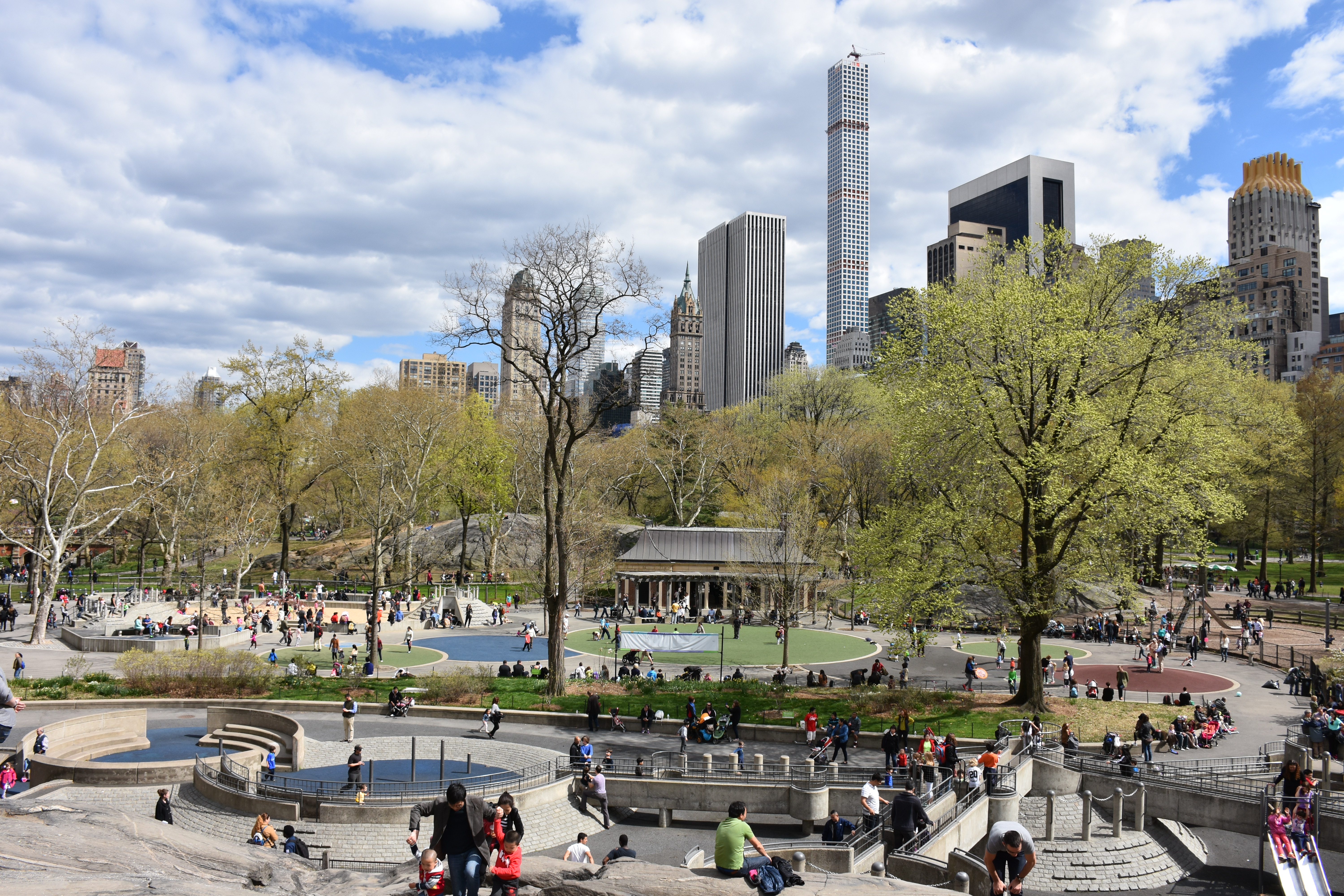
Heckscher Playground in Central Park. Credit: CC BY-SA 4.0
- 10 of the Best Urban Projects in the World by Erisa Nesimi
- How Bishan Park Became “The Central Park” of Singapore by Win Phyo
- How Can a Park Become “A Lung for the City”? by Irmak Bilir
Featured image: Central Park from Rockefeller Center | New York, New York | Andrew Mace | 2015
10 Reasons to Go on a Landscape Architecture Exchange
Article by Emily Sinclair Discover why landscape architecture students should embark on a foreign exchange. There are many clear advantages to participating in an exchange program during your time in university. From learning a new language to experiencing a new culture, becoming a foreign exchange student can change your perspective on the world around you. As landscape architecture students, we all deal with the design of spaces and the surrounding environments in our projects. While we can study theory, and delve into case studies of monumental landscape works, there is no alternative to visiting the space in person. Traveling is always an option, but there are benefits to spending a semester abroad as a landscape architecture student. 10. Exposure to Projects As mentioned above, while studying a space can be useful to your studies and forming your personal design style, nothing quite takes the place of visiting a project in person. Landscape architecture is found worldwide and each country takes its own approach to the field. By traveling to new countries, you are not only opening your mind to new experiences, but also new philosophies and values. By exploring projects with your feet, eyes, and sketchbook rather than your textbook, you can draw your own conclusions and discover something you didn’t expect to find.

Kyrkogårdsförvaltningen, Malmö, Sweden. Credit: Emily Sinclair

Ribersborgsstranden in the Winter, Malmö, Sweden. Credit: Emily Sinclair

A Swedish ‘Champagne’ Breakfast. Credit: Emily Sinclair

Bern, Switzerland. Credit: Emily Sinclair

Always Bring a Sketchbook. Credit: Emily Sinclair
- 10 Great Places to Study Landscape Architecture in Europe by Erin Tharp
- 5 Cities a Landscape Architecture Student Should Visit and Why by Eleni Tsirintani
- 10 Great Countries for Living and Working Abroad by Alexandra Antipi
Featured image: Slottstradgarden | Malmö, Sweden | Emily Sinclair | 2017





